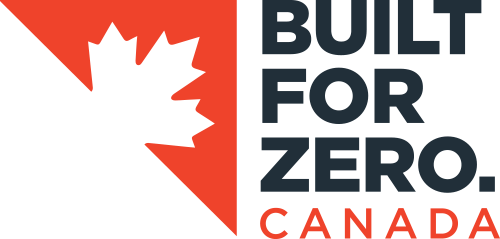Experimenting with, adapting, and improving new technologies is helping these Built for Zero Canada communities improve their collaborative and coordinated outreach. This blog is a part of our Bright Spot series highlighting outstanding work in ending homelessness happening across Canada.
 Two Built for Zero communities – Kelowna, British Columbia and Niagara Region, Ontario, are coordinating regional outreach efforts with the help of technology tailored to their local contexts. Strong, coordinated, and housing-focused outreach is essential for ending homelessness, making these two communities well-equipped to do so thanks to their collaborative efforts and experimentation with new technologies.
Two Built for Zero communities – Kelowna, British Columbia and Niagara Region, Ontario, are coordinating regional outreach efforts with the help of technology tailored to their local contexts. Strong, coordinated, and housing-focused outreach is essential for ending homelessness, making these two communities well-equipped to do so thanks to their collaborative efforts and experimentation with new technologies.
Coordinated outreach is important for ensuring that homelessness service providers are aware of, and in contact with, those who are unsheltered and not otherwise being connected to services. It also helps to understand community hotspots, map, coordinate, and document outreach programs, and ensure that By-Name Lists are comprehensive to connect people sleeping rough to housing. That is why both Kelowna and Niagara Region have been testing and improving region-wide collaboratives to coordinate outreach efforts and they are hoping that technology can enhance their efforts.
Both Kelowna and Niagara Region are also testing and adopting technologies to aid in their coordinated outreach efforts with varying levels of success.
Niagara successfully implements technological solutions
In Niagara Region, a cross-agency collaborative known as the Niagara Assertive Street Outreach (NASO) team has been meeting weekly since April of last year. It includes police liaison officers, primary doctors, community paramedics, and 12 full-time outreach workers that come together from several organizations across the region.
The large Niagara Region has had success with technological solutions. Soon after their NASO team was established, they quickly connected with 211 Ontario to coordinate referrals, tested and adopted a modified version of the ArcGIS system, which is used as a hotspot mapping tool, and finessed the use of HIFIS 4 (a homelessness management information system) to support case management and facilitate additions and updates to Niagara’s By-Name List, which is solely populated through data stored in HIFIS.
“The team grew very quickly and required changes in process, including embracing technology options in order to ensure the program would be successful,” says Carla Montana, Service System and Performance Management Advisor, Niagara Region.
The collaboration between Niagara Region and 211 has become integral to coordinating outreach and connecting people to NASO across all 12 municipalities that make-up Niagara Region. Voicemails are accepted 24/7 and automatically sent to Microsoft Teams for NASO to coordinate intake, each call is logged, phone lines are monitored, callback times are efficient, and there is less risk for information breakdown.
“Ultimately, these pieces of tech have made us incredibly more efficient and effective at having the information we need at hand for a client, and being able to make things happen or available for our client when they are ready for them. In that way, we can always hold the door open for them,” says Mackenzie Hamilton, Niagara Assertive Street Outreach (NASO) Worker.
NASO’s collaborative efforts have also strengthened community partnerships, including relationships between municipalities and between housing and homelessness programs across the region.
“The [NASO] team has been able to partner with existing service providers to leverage each other’s resources and expertise,” Carla says.
Kelowna establishes a critical framework for coordination
In Kelowna, a 29-person working group called the Coordinated Outreach Table formed as a result of a partnership between CMHA and the Central Okanagan Journey Home Society, to identify trends, fill gaps, and shape the future of the community’s outreach. This group meets weekly and includes members from the RCMP, Interior Health, and the Lived Experience Circle on Homelessness.
“The walls surrounding service providers are finally starting to come down, and it’s an extremely exciting time to be involved in the sector,” says Malcolm Evans, Senior Homelessness Outreach Navigator for CMHA Kelowna. “Our community and the service providers within it have an intense hunger for collaboration.”
“Everyone is at the table and is working hard to improve our services.”
In Kelowna, communication challenges between the organizations responsible for outreach has historically led to fragmentation, reduced efficiency, and identity issues for each organization. During the pandemic, however, the consistent and collaborative efforts of Kelowna’s Coordinated Outreach Table have helped sector workers quickly adapt to the ever-changing homelessness landscape, achieve tangible improvements in their work, and in turn, gain community buy-in.
“Our hunger for collaboration has resulted in significant momentum for community initiatives. From coordinated access to coordinated shelter and now coordinated outreach, we are establishing a critical framework for coordination in our sector,” Malcolm says.
Kelowna’s Coordinated Outreach Table hopes to continue strengthening the sector’s overall effectiveness with the use of new technologies to improve information-storage, -organization, and -sharing.
“In the midst of the fantastic progress that has been made, we still face challenges, perhaps the most significant being the challenge of data-sharing across organizations, and the impact that this has on broader system coordination,” Malcolm notes.
Last fall, the City of Kelowna converted their GIS system, called ArcGIS, to an app that can be used to track encampments and unsheltered individuals. This was meant to allow for the rapid mobilization of outreach teams to new encampments in the community. It was also expected to reduce overlap between outreach organizations and service engagement fatigue among clients. The app is currently not being used due to a number of limitations uncovered during development, most notably the absence of data sharing agreements and infrastructure among partners. However, the app has been designed to have the potential to feed into an integrated data platform and could have a future role, as underlying information sharing limitations are resolved. Regardless of future use, the app has been critical in uncovering integration limitations and pushing progress on coordination of data sharing.
Kelowna is now hoping to develop new technological systems that can facilitate coordination, particularly between their Coordinated Outreach, Coordinated Access, and Coordinated Shelter Tables, which together provide service coverage from unsheltered homelessness through to permanent housing.
“If we can find a way to collaborate with one another, we can move towards a community that supports consenting individuals throughout their journey, whether they’re evicted from supportive housing, spend winters in shelters and summers on the street, or experience a linear progression through our system,” Malcolm says.
A model for coordination
Coordination among outreach workers and organizations ultimately benefits their homeless clients and neighbours. It ensures that they receive more focused, efficient, and effective service. While technological tools can support these coordination efforts, a commitment to collaboration among organizations and stakeholders is paramount, making both Kelowna and Niagara Region excellent models for how other communities can improve their cross-sector communication, information-sharing, and service quality.
Learn more about Kelowna and Niagara’s efforts in this free webinar from January 28, Coordinating Outreach and Using Technology:
- Watch webinar
- View presentation slides
- See further information and resources on housing-focussed here
This blog is a part of our Bright Spot series highlighting outstanding work in ending homelessness happening across Canada.
